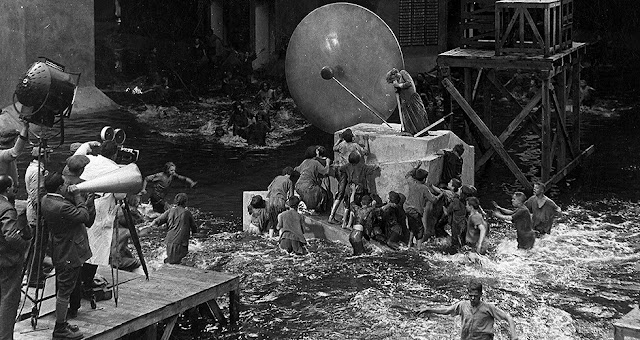[Major spoiler alert for all
of this entry.] One of the first plot elements of The Madagaskar Plan I
came up with was the ending, inspired by the climax of Metropolis (one of my favourite films). Plotting is often like
doing a puzzle. I start with a solitary piece and then have to find others around
it to create a picture. The RESERVATIONS are a good example of this.
 |
| Filming the flood in Metropolis |
In my very earliest notes
for the book I have the following: ‘Ending = apocalyptic flood’. What could
cause such a thing? The only thing I could think of was a dam burst. There is a
brief mention in Afrika Reich about
Hochburg using dams to harness the power of the continent, so it seemed
plausible something similar was happening in Madagascar. I looked to see if
there were any real dams on the island but there aren’t, at least not of any
significance. Then in my research I came across a lucky find. In 1949 France’s
main electricity company sent a team to Madagascar to survey the island’s hydroelectric
potential. Their report – a document running to hundreds of pages – was invaluable
as it not only listed potential rivers that could be used for electricity but
also the drawbacks of them. I knew the dam would have to be in the north of the
island and by a process of elimination settled on the one proposed across the
Sofia River. Then another great detail – the French team feared the river might
carry too much silt, leading to turbine clogging. Rather than discouraging me
this inspired me – because it said something about Globus’s character: he was
prepared to build a folly.
The next question was why
would so many Jews live in the valley of the dam – a potentially dangerous
site. If the creative process is alchemic (as I’ve written elsewhere) or a kind
of puzzle, it is also like weaving a tapestry; individual threads come together
to form an image. Much of this ‘mind weaving’ is an unconscious process. The Nazis
were obsessed with putting Jews in reservations. The most famous of these was
the Lublin Reservation, often considered a precursor to the Madagascar Plan. It
was overseen by Globocnik. So somewhere in my head I made a link between dams
and reservations and they tied together perfectly.
The only thing left to do
was to visit an actual dam. I wanted a remote one, so when I was in the US a
couple of years ago I made a lengthy detour to Idaho and the Hell’s Canyon hydroelectric
plant – upon which the dam in the book is based. As with my trip to Madagascar,
walking the ground was invaluable, providing details I couldn’t have picked up
from books alone: the constant hum of generators; the faint smell of brine from
the reservoir. It also made for an eventful drive, like something out of Duel... but that is a story for another
time.
 |
| Hell's Canyon Dam, Idaho |
R is also for Rolland
Vice-admiral Rolland is the
man who gives Salois his mission. Some of you may recognise the name. Admiral
Rolland is also the character that sets Smith and Schaeffer on their mission in
Where Eagles Dare. He was played by
Michael Hornden.
 |
| Hornden as Rolland in Where Eagles Dare |
Originally, I wanted to give
Salois the call sign Smith uses, ‘Broadsword’. But in recent years it has
become too ubiquitous, so I settled instead for another, less well known call
sign, one that subtly ties into the plot: ‘Dragonfly’. I’ll leave you to
discover where it’s from...
No comments:
Post a Comment